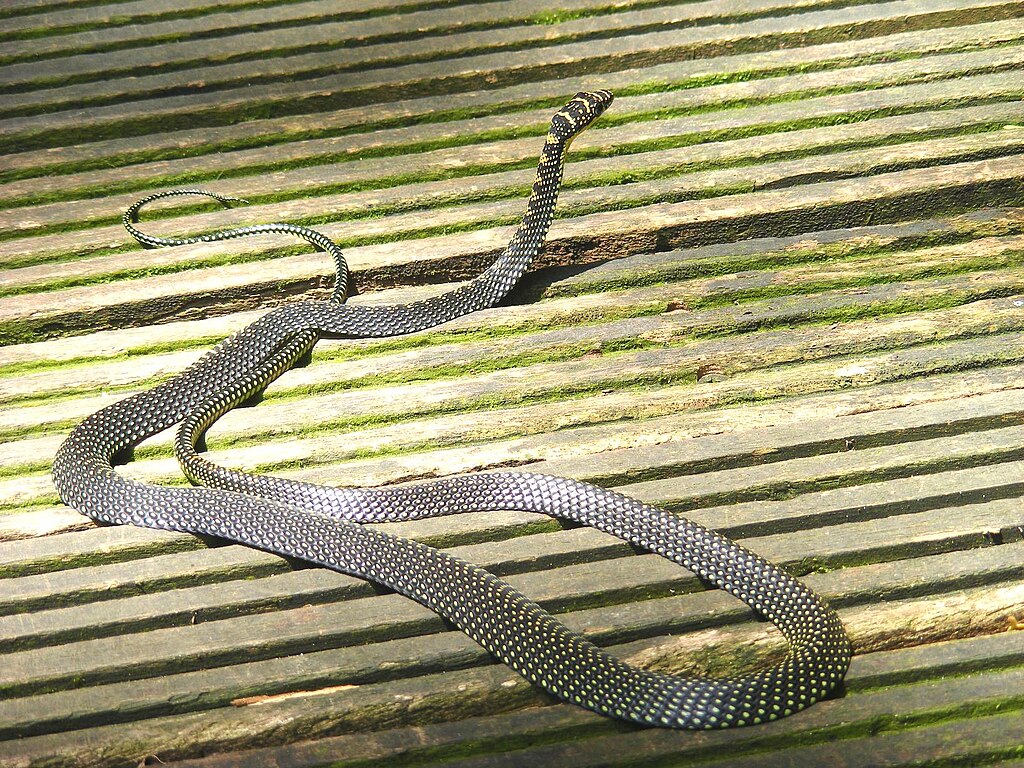Deep within the dense tropical forests of Southeast Asia, a remarkable reptile defies our expectations of what snakes can do. The paradise tree snake (Chrysopelea paradisi) performs an extraordinary feat that seems to contradict everything we understand about these limbless creatures – it can glide through the air with astonishing precision. Often referred to as “flying snakes,” these animals don’t truly fly in the sense that birds or bats do, but their aerial abilities are nonetheless spectacular and unique in the reptile world. Through specialized behaviors and body adaptations, these remarkable serpents have evolved a method of traversing their forest home that continues to fascinate scientists and nature enthusiasts alike. Let’s explore the fascinating world of these gravity-defying reptiles and uncover the science behind their remarkable “flight.”
The Flying Snake Family
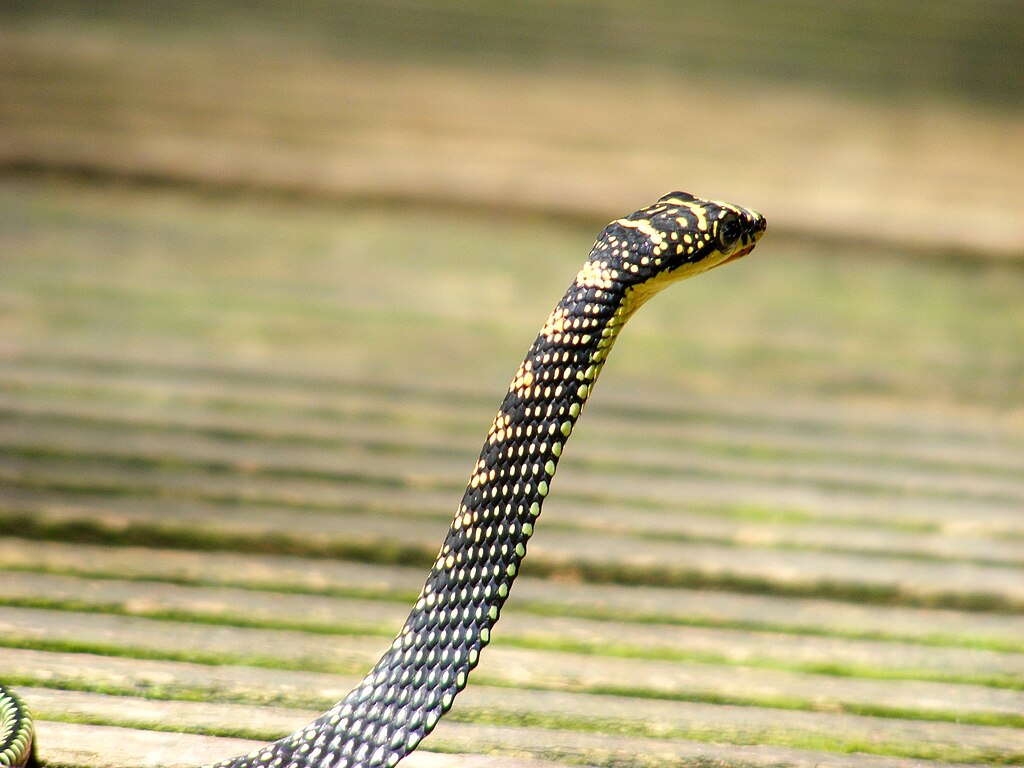
The paradise tree snake belongs to the genus Chrysopelea, which contains five recognized species of flying snakes native to South and Southeast Asia. All members of this genus possess some gliding ability, but the paradise tree snake (C. paradisi) and the golden tree snake (C. ornata) are particularly adept aerial navigators. These colubrid snakes are part of the Colubridae family, which contains about two-thirds of all known snake species. While most of their relatives remain firmly bound to terra firma, the Chrysopelea genus has evolved this specialized locomotion method that sets them apart from virtually all other serpents. Their evolutionary divergence represents a fascinating adaptation to life in the forest canopy, where the ability to move efficiently between trees provides significant advantages for hunting and escaping predators.
Physical Characteristics of Flying Snakes
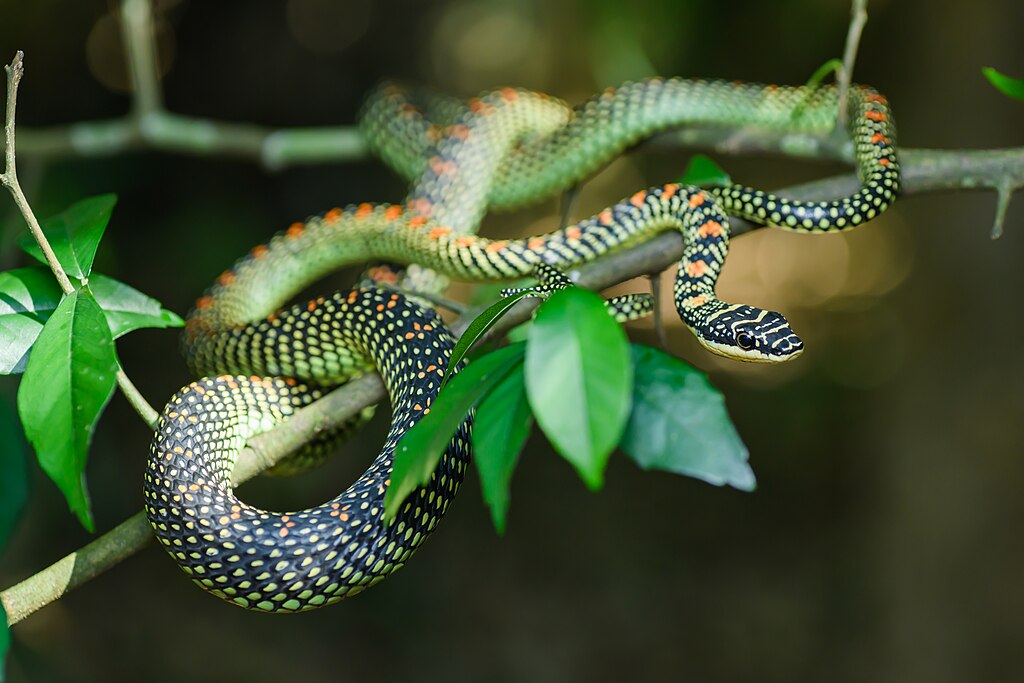
Paradise tree snakes are relatively slender reptiles, typically growing to lengths of 3 to 4 feet (0.9 to 1.2 meters). Their bodies display striking coloration patterns that include black, green, and yellow scales arranged in intricate designs, which provide excellent camouflage among the forest foliage. Perhaps their most distinctive physical feature is their flattened underbelly, which contains a ridge running down each side that can be pushed outward during gliding. This unique anatomical structure is crucial to their aerial capabilities. Unlike other gliding animals such as flying squirrels or lizards, flying snakes don’t possess specialized membranes or skin flaps to generate lift. Instead, they use their entire body as an airfoil, creating a concave shape that captures air and generates lift through a complex interplay of physics and biomechanics.
The Mechanics of Snake “Flight”
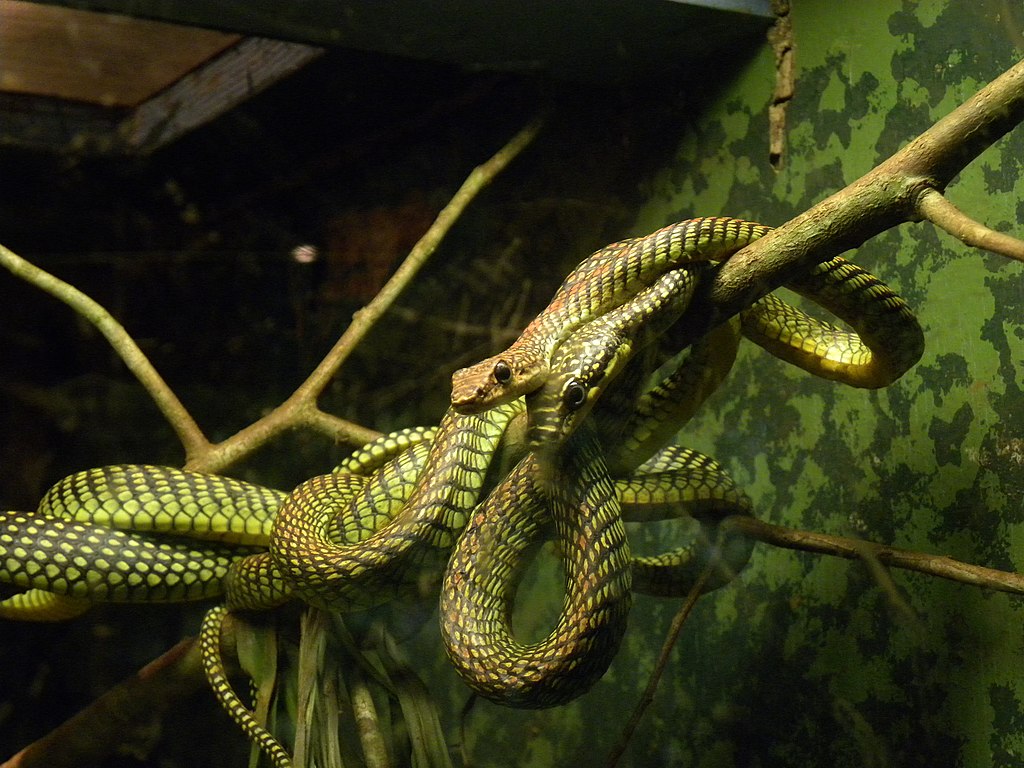
What flying snakes do isn’t technically flight but rather a sophisticated form of gliding. To initiate their aerial journey, the snake first climbs to a suitable height in a tree, then dangles from a branch with the front portion of its body formed into a J-shape. In a dramatic launch, it propels itself away from the branch with the rear portion of its body, essentially jumping into the air. Once airborne, the snake performs its most remarkable transformation – it flattens its body by spreading its ribs and pulling in its ventral surface, effectively doubling its width while creating a concave shape similar to a frisbee. This body configuration generates aerodynamic lift as air flows around it. While gliding, the snake performs undulating S-shaped movements, not just for stability but actively to generate lift and control its trajectory. These aerial acrobatics allow the snake to travel impressive horizontal distances, sometimes exceeding 100 feet (30 meters) in a single glide.
Scientific Research on Flying Snakes
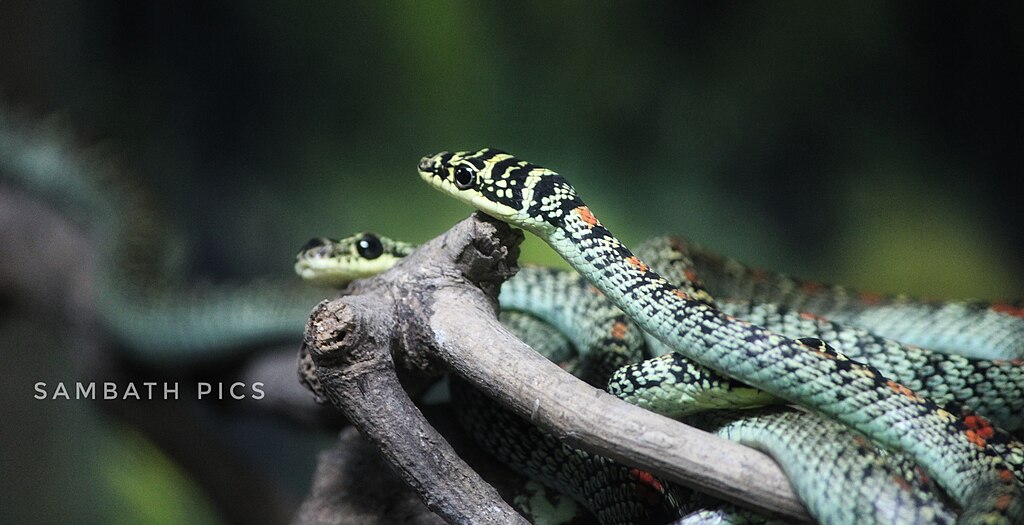
The aerial capabilities of flying snakes have attracted significant scientific interest, particularly in the fields of biomechanics and aerodynamics. Pioneering research by Jake Socha, a biomechanist at Virginia Tech, has significantly advanced our understanding of how these reptiles achieve their impressive glides. Using high-speed cameras, 3D motion capture technology, and computational fluid dynamics, Socha and his team have documented the complex body positions and movements that generate lift during gliding. Their research has revealed that flying snakes achieve surprisingly good glide ratios – the distance traveled horizontally compared to the vertical distance descended. Some studies have even suggested that the undulating motion flying snakes make while airborne might actually create tiny vortices that further enhance lift, though this mechanism is still being investigated. This ongoing research not only illuminates a fascinating biological adaptation but could potentially inspire innovations in aerodynamic design and robotics.
Habitat and Geographic Distribution
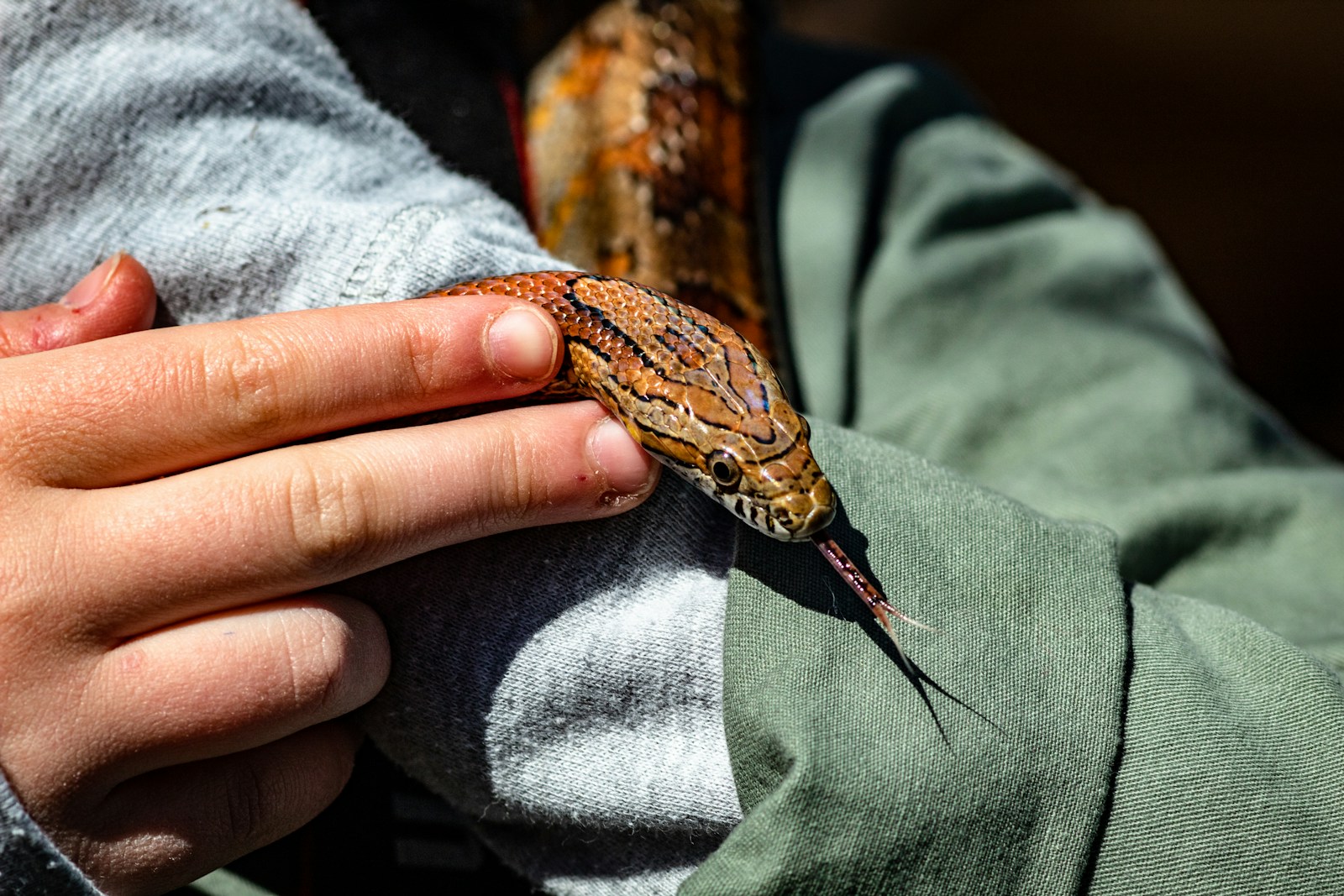
Flying snakes inhabit the tropical forests of South and Southeast Asia, with their range extending from western India and Sri Lanka through mainland Southeast Asia to the Philippine archipelago and Indonesian islands. They are particularly prevalent in countries like Thailand, Malaysia, Singapore, and Indonesia, where dense forest canopies provide ideal conditions for their arboreal lifestyle and gliding behaviors. These snakes thrive in primary and secondary forests, preferring environments with tall trees and diverse canopy structures that facilitate their unique mode of transportation. The fragmentation of these forest habitats due to deforestation and human development presents a growing threat to flying snake populations. Their specialized adaptation to canopy living makes them particularly vulnerable to habitat loss, as their gliding ability becomes less advantageous in forests with disconnected canopies or in areas where tall trees have been removed.
Hunting and Diet
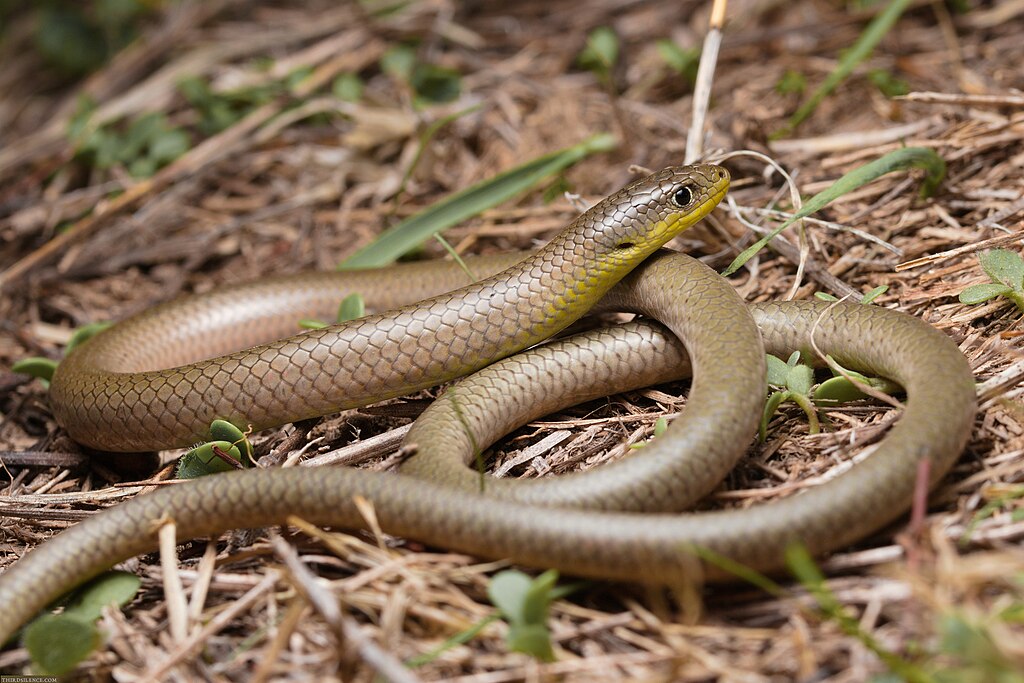
Paradise tree snakes are skilled hunters that prey primarily on small forest vertebrates, with lizards forming a substantial portion of their diet. Their menu also includes small birds, bats, frogs, and occasionally rodents that inhabit the forest canopy. These snakes are diurnal predators, meaning they hunt during daylight hours when their exceptional vision and agility give them advantages in pursuing prey through the complex three-dimensional environment of the forest canopy. Their gliding ability serves as both a hunting strategy and an energy-efficient method of travel between feeding areas. After spotting potential prey, a flying snake might glide from one tree to another to initiate a stealthy approach, reducing the energy expenditure required for hunting in their vast arboreal territory. While they possess mild venom delivered through rear fangs, this venom primarily serves to subdue their small prey rather than as a defense mechanism against larger animals.
Flying as a Predator Evasion Strategy
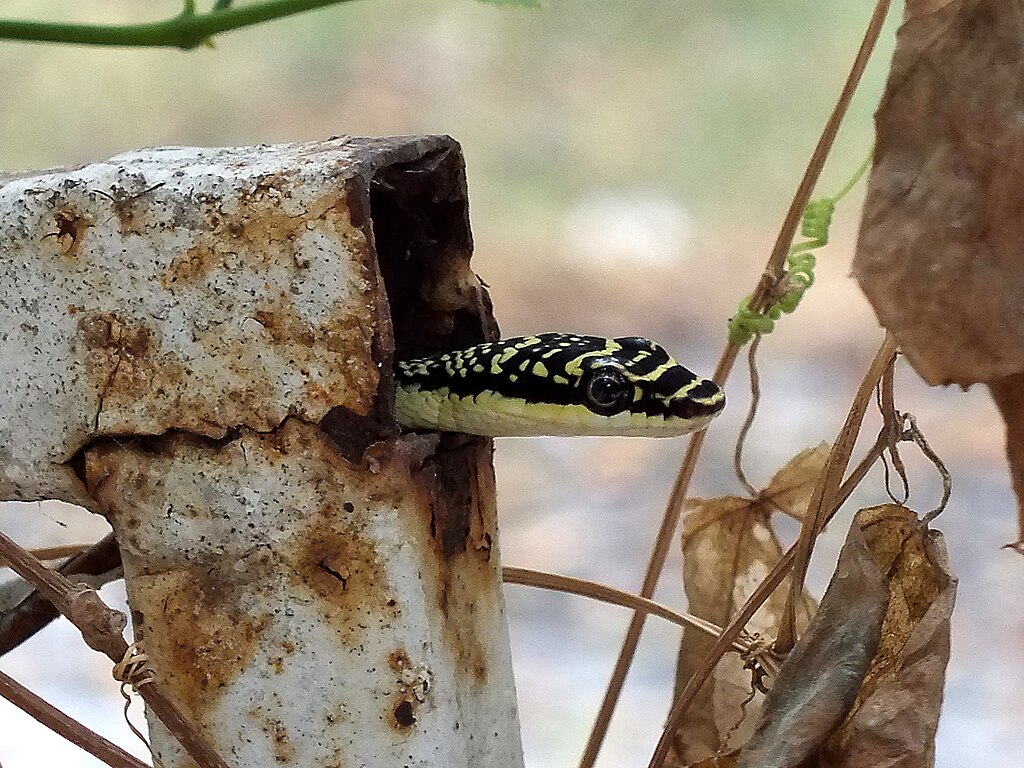
Beyond its utility in hunting, the gliding ability of paradise tree snakes serves as a remarkable adaptation for escaping predators. When threatened by birds of prey, larger snakes, or primates that might target them in the canopy, flying snakes can rapidly launch themselves into the air, effectively disappearing from the threatening situation. This escape method is particularly effective because it allows the snake to quickly cover significant distances while making their trajectory difficult for predators to predict. The snake’s ability to control its glide path means it can aim for specific landing spots, potentially diving into dense foliage where it can quickly disappear from sight. This predator evasion strategy represents a fascinating evolutionary solution to the challenges of surviving in an environment where threats can come from multiple directions and where traditional escape routes might be limited by the vertical structure of the forest.
Reproduction and Life Cycle

The reproduction of paradise tree snakes follows patterns typical of many colubrid species, though adapted to their arboreal lifestyle. Unlike many other snakes, flying snakes are oviparous, meaning females lay eggs rather than giving birth to live young. During the breeding season, males actively search for receptive females, sometimes engaging in competitive interactions with rival males. After successful mating, the female will lay a clutch of 6-12 eggs in sheltered locations such as tree hollows, crevices, or accumulated plant debris in the canopy. The mother provides no further parental care once the eggs are deposited in a suitable location. After an incubation period of approximately 8-10 weeks, the eggs hatch, producing fully-formed but miniature versions of the adults. These juvenile snakes possess innate gliding abilities, though their skills improve with practice as they mature. Young flying snakes face significant challenges, with high mortality rates due to predation, but those that survive can live for 8-10 years in the wild.
Conservation Status and Threats
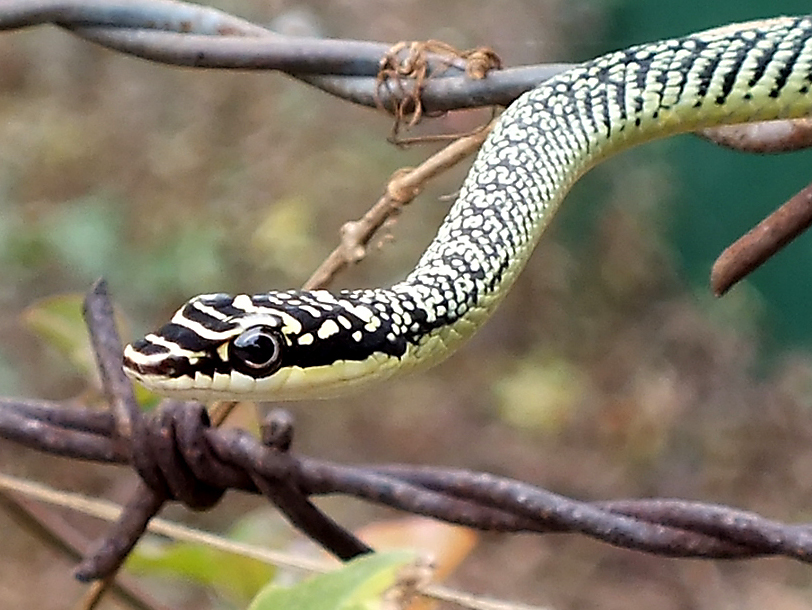
While flying snakes have not been comprehensively assessed by major conservation organizations like the IUCN, they face several significant threats in their native habitats. The most pressing concern is habitat loss due to deforestation for agriculture, particularly palm oil plantations, logging operations, and urban development throughout Southeast Asia. These activities fragment the forest canopy that flying snakes depend on for their specialized mode of transportation. Climate change presents additional challenges, potentially altering forest ecosystems and affecting prey availability. Although not heavily targeted by the international wildlife trade, flying snakes are occasionally collected for the exotic pet trade due to their unique abilities and striking appearance. Local superstitions and fear of snakes can also lead to persecution in some areas, despite the fact that flying snakes pose virtually no threat to humans. Conservation efforts focused on protecting intact forest ecosystems indirectly benefit these remarkable reptiles by preserving their specialized habitat.
Interacting with Humans
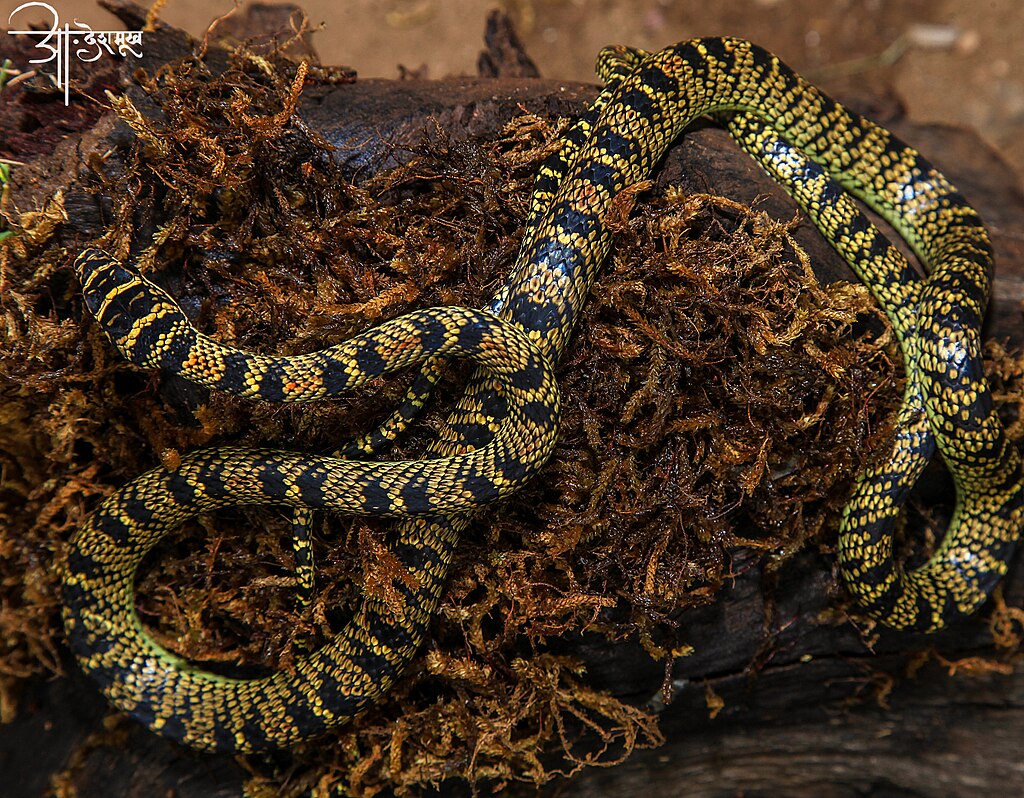
Despite their somewhat intimidating reputation as “flying snakes,” paradise tree snakes pose little danger to humans. They are generally non-aggressive and prefer to flee rather than confront potential threats. Although they do possess mild venom delivered through rear fangs (making them opisthoglyphous), this venom is primarily adapted for subduing their small prey and is not medically significant to humans. Bites are extremely rare and typically occur only when the snakes are handled or directly threatened. In many parts of their range, flying snakes are viewed with a mixture of fascination and apprehension by local communities. Some traditional beliefs attribute supernatural qualities to these animals due to their unusual locomotion. For wildlife enthusiasts and ecotourists, spotting a flying snake in action represents a remarkable and memorable wildlife encounter, though the secretive nature of these reptiles and their canopy lifestyle makes such observations relatively uncommon without dedicated effort.
Flying Snakes in Popular Culture
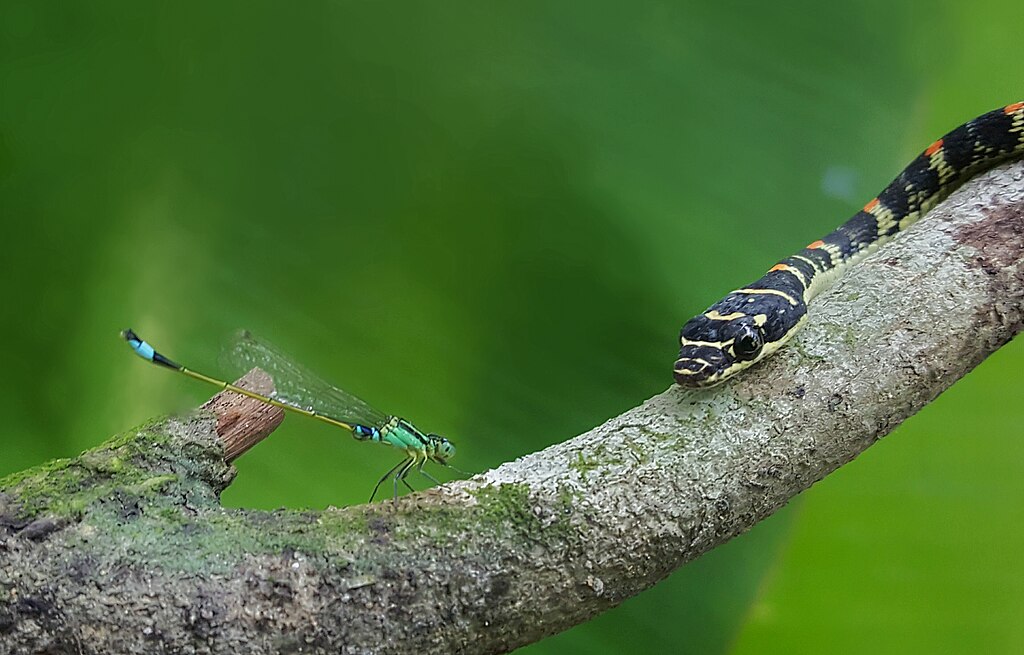
The concept of a flying snake has captured human imagination well beyond scientific circles, featuring in various aspects of popular culture. These remarkable reptiles have appeared in numerous nature documentaries, with their dramatic gliding sequences often highlighted as examples of nature’s extraordinary adaptations. Online videos of flying snakes in action frequently go viral, generating millions of views and introducing these animals to audiences worldwide. In fiction and mythology, the idea of flying or aerial serpents predates scientific understanding of actual flying snakes, appearing in legends from various cultures ranging from the European wyvern to the feathered serpent Quetzalcoatl of Mesoamerican mythology. Modern fantasy literature and games have embraced the flying snake concept, often taking creative liberties to depict serpents with wings or magical flying abilities far beyond those of real Chrysopelea species. This cultural fascination reflects humanity’s enduring interest in animals that transcend expected limitations, particularly when they involve creatures already imbued with symbolic significance across human cultures.
Similar Adaptations in Other Animals
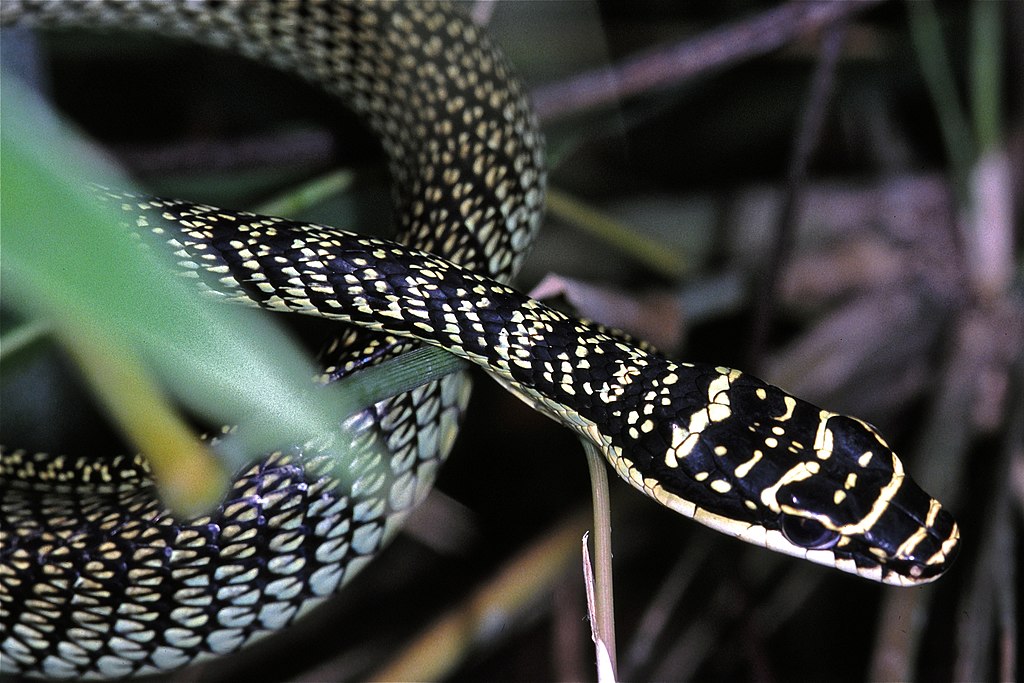
The evolution of gliding as a locomotion strategy has occurred independently in multiple animal lineages, representing a fascinating case of convergent evolution. While flying snakes have developed perhaps the most surprising implementation of this ability, other forest animals have evolved their own approaches to aerial movement. Flying squirrels use a membrane of skin called a patagium that stretches between their limbs to create a wing-like surface. Colugos, sometimes called flying lemurs (though they aren’t true lemurs), possess the most extensive gliding membranes of any mammal, creating an almost square gliding surface. Among reptiles, the draco lizards have evolved specialized elongated ribs that can extend outward to support wing-like flaps of skin. Even certain species of frogs have developed enlarged webbed feet and skin flaps that allow them to extend their jumping leaps into controlled glides. Each of these adaptations represents a unique evolutionary solution to the challenge of moving efficiently through a three-dimensional forest environment, though none perhaps as unexpected as the method employed by flying snakes.
Future Research Directions
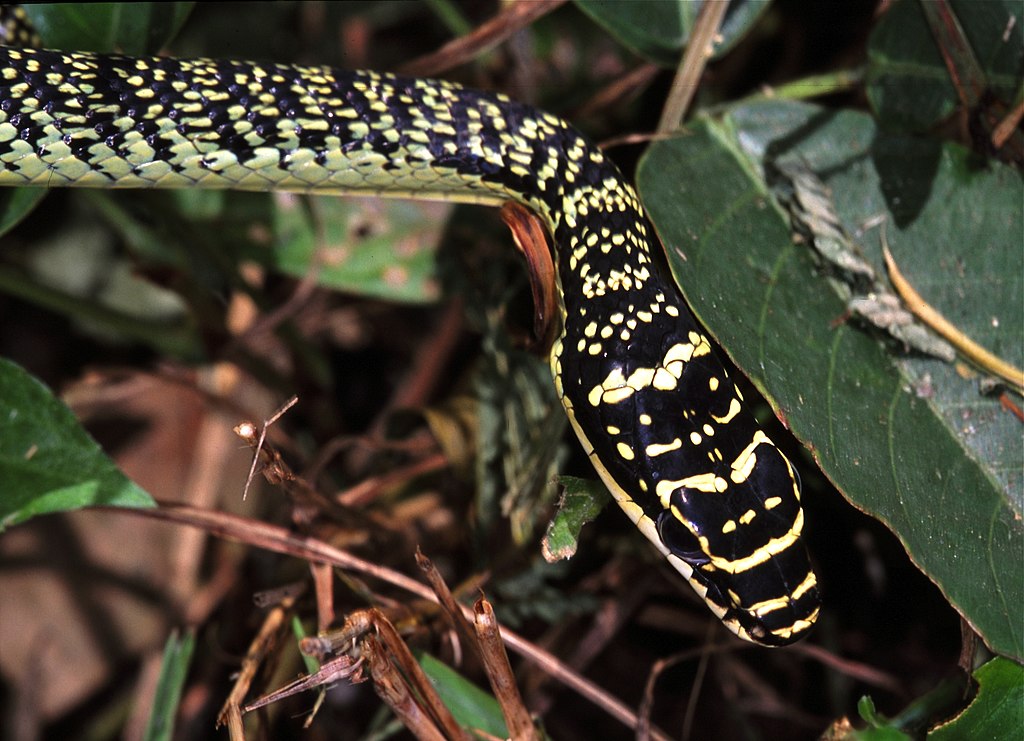
The unique gliding adaptation of flying snakes continues to inspire scientific inquiry across multiple disciplines. Biomechanics researchers are still working to fully understand the complex fluid dynamics that enable these limbless reptiles to generate lift and control their aerial trajectory. This research could potentially inform novel approaches to drone design, particularly for small aerial vehicles that need to navigate complex environments. Evolutionary biologists remain interested in mapping the genetic underpinnings of this specialized behavior and tracking its development throughout the evolutionary history of the Chrysopelea genus. Ecological studies focusing on how habitat fragmentation affects the movement patterns and population dynamics of flying snakes could provide valuable insights for conservation planning. Advances in lightweight tracking technology might soon allow researchers to monitor the three-dimensional movements of these snakes throughout the forest canopy, potentially revealing new aspects of their behavior and ecology. As climate change and habitat loss continue to threaten tropical forest ecosystems, understanding specialized animals like flying snakes becomes increasingly important for conservation efforts.
The paradise tree snake and its flying relatives represent one of nature’s most remarkable evolutionary innovations. By transforming their entire body into an airfoil and using sophisticated control mechanisms, these reptiles have conquered the aerial dimension of the forest in a way no other snake has achieved. Their specialized adaptation showcases nature’s boundless creativity in solving environmental challenges. As we continue to study these extraordinary creatures, we not only gain insights into the marvels of biological adaptation but also find inspiration for human innovation. The flying snake reminds us that even in well-studied animal groups, extraordinary and unexpected capabilities can evolve, challenging our preconceptions about what is possible in the natural world.

